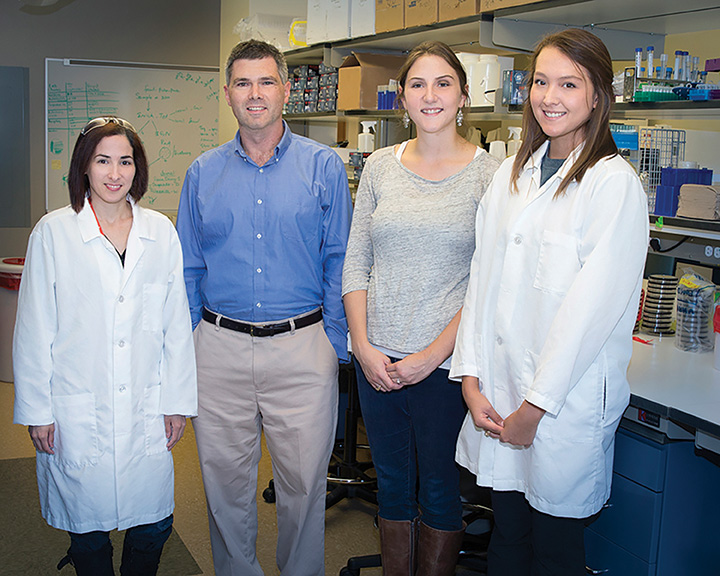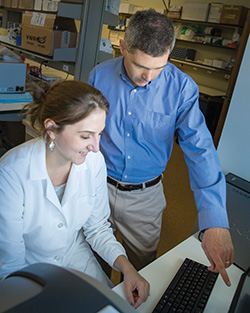Powerful Collaborations Work to Solve Multifactorial Salmonella Challenge
“We’ve made little progress in reducing the incidence of salmonellosis in people over the last 15 years. As a result, salmonella remains one of our predominant threats to food safety,” said Dr. Kevin Cummings, assistant professor of epidemiology in the Department of Veterinary Integrative Biosciences at the Texas A&M College of Veterinary Medicine & Biomedical Sciences (CVM).

One of the reasons for the relative lack of progress may be the complex ecology of the bacterium itself. “Salmonella can be found in the gastrointestinal tract of a very wide range of hosts,” Cummings said. “In addition, it can survive for extended periods of time in a broad array of environments. These features make salmonella a formidable challenge.”
Most coverage of salmonella in the popular press has revolved around outbreaks that resulted from food consumption, and Cummings notes that this is still the most common pathway for salmonella infection. However, he also adds that the role that direct contact with infected animals plays in salmonella infection is generally underestimated. “The bottom line is that in addition to our vigilance with food safety, we must practice safe animal contact,” Cummings said. “As for the foodborne cases, it’s also important to remember that large outbreaks actually represent just the tip of the iceberg in terms of overall disease burden.”
For researchers like Cummings, the challenge of the multifactorial salmonella problem is best addressed using a collaborative One Health approach. The One Health concept is based on the inextricable link between animal, human, and environmental health. Because salmonella affects animals and humans and is persistent in the environment, a team representing different viewpoints is needed. “Collaborative approaches allow us to address problems through multiple perspectives,” Cummings said. “With salmonella, for example, we have microbiologists studying the organism itself, clinicians treating individual patients, and epidemiologists looking at the level of disease and associated risk factors at the population level. This multidisciplinary plan of attack maximizes our chances of discovering new methods to control the pathogen. The combining of disciplines to solve tricky problems is one of the most exciting parts of academia.”
Cummings regularly collaborates with faculty across departments at Texas A&M, faculty at other universities, colleagues at state and federal government agencies, and colleagues in industry. His multidisciplinary approach can be seen in his own lab, as exemplified by Dr. Lorraine Rodriguez-Rivera, a postdoctoral research associate in the Cummings lab. Rodriguez-Rivera has expertise in the microbiology of salmonella and other bacterial pathogens. “We have unique perspectives and areas of expertise, thus allowing a synergistic approach when investigating salmonella and other foodborne disease agents,” Cummings said.
Several research projects are ongoing in the Cummings lab. One of his main research aims is to determine the role of various wildlife species as reservoirs of salmonella and other pathogens. Thus, he is investigating the role of feral pigs in the epidemiology of salmonella and three additional zoonotic agents. “Feral pigs are an emerging One Health threat,” Cummings said. “They are one of the most abundant free-roaming ungulates in the United States, with a population that might be as high as 8 million. Feral pigs invade and contaminate crop fields, they contaminate surface waters, and they serve as a potential source of pathogen transmission to livestock. All of these things pose a risk to food safety.”

Cummings is also interested in the role that livestock play in the ecology and transmission of salmonella. Currently he is using genomic techniques to study an emerging strain of salmonella among dairy cattle. This project, in collaboration with investigators at Cornell University, is an extension of work that he did as a Ph.D. student. “The sharp rise in isolation of this strain from sick dairy cattle presents a very unique opportunity to investigate pathogen emergence in real time,” Cummings said.
Another primary objective of the Cummings lab is to tackle the issue of antimicrobial resistance among salmonella and other foodborne pathogens. Antimicrobial resistance limits treatment options for veterinary patients, and it represents a threat to public health. “The antimicrobial resistance issue is inherently complex with a lot of moving parts, to say the least,” Cummings said. “We are now studying antimicrobial resistance trends within a variety of host species, and this work opens new doors in terms of focusing new research questions. We’re also investigating the role of environmental reservoirs in promoting the emergence and persistence of antimicrobial-resistant salmonella on dairy operations.”
Both a veterinarian and an epidemiologist, Cummings has studied salmonella from both the clinical and the research side. “Having been in practice, I have a perspective of knowing what the big problems are, as well as what solutions would be practical,” Cummings said. “This helped me immensely when I began my research career, in terms of framing my research questions.” Being a clinician also helped Cummings see the effect of salmonellosis firsthand in his patients. “Besides being a major threat to public health, salmonella is an important cause of disease in many of our veterinary patients, such as cattle, horses, and pigs,” Cummings said. “So, when progress is made against a pathogen like salmonella, we all win. It doesn’t get any better than that.”


